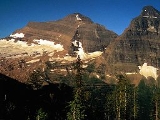
Livingston Range
Encyclopedia
The Livingston Range is a mountain range
located primarily in Glacier National Park in the U.S. state
of Montana
, and in the extreme southeastern section of the Canadian
province of British Columbia
. The range is 36 miles (57.9 km) long and 28 miles (45.1 km) wide. Over 15 summits exceed 9000 ft (2,743.2 m) above sea level, and the highest point is Kintla Peak
at 10101 feet (3,079 m). (While these elevations are not particularly high for North America
n mountains, they are high compared to the roughly 4,000 foot (1,200 m) elevation of the nearby valleys, making for particularly dramatic peaks.)
The Livingston Range was initially uplifted beginning 170 million years ago when the Lewis Overthrust
fault pushed an enormous slap of precambrian
rocks 3 mi (4.8 km) thick, 50 miles (80.5 km) wide and 160 miles (257.5 km) long over newer rocks of the cretaceous
period.
Mountain range
A mountain range is a single, large mass consisting of a succession of mountains or narrowly spaced mountain ridges, with or without peaks, closely related in position, direction, formation, and age; a component part of a mountain system or of a mountain chain...
located primarily in Glacier National Park in the U.S. state
U.S. state
A U.S. state is any one of the 50 federated states of the United States of America that share sovereignty with the federal government. Because of this shared sovereignty, an American is a citizen both of the federal entity and of his or her state of domicile. Four states use the official title of...
of Montana
Montana
Montana is a state in the Western United States. The western third of Montana contains numerous mountain ranges. Smaller, "island ranges" are found in the central third of the state, for a total of 77 named ranges of the Rocky Mountains. This geographical fact is reflected in the state's name,...
, and in the extreme southeastern section of the Canadian
Canada
Canada is a North American country consisting of ten provinces and three territories. Located in the northern part of the continent, it extends from the Atlantic Ocean in the east to the Pacific Ocean in the west, and northward into the Arctic Ocean...
province of British Columbia
British Columbia
British Columbia is the westernmost of Canada's provinces and is known for its natural beauty, as reflected in its Latin motto, Splendor sine occasu . Its name was chosen by Queen Victoria in 1858...
. The range is 36 miles (57.9 km) long and 28 miles (45.1 km) wide. Over 15 summits exceed 9000 ft (2,743.2 m) above sea level, and the highest point is Kintla Peak
Kintla Peak
Kintla Peak is located in the Livingston Range, Glacier National Park in the U.S. state of Montana. Kintla Peak is the tallest mountain in the Livingston Range and the third tallest in Glacier National Park. The mountain is in the remote northwest corner of the park and requires a hike of almost ...
at 10101 feet (3,079 m). (While these elevations are not particularly high for North America
North America
North America is a continent wholly within the Northern Hemisphere and almost wholly within the Western Hemisphere. It is also considered a northern subcontinent of the Americas...
n mountains, they are high compared to the roughly 4,000 foot (1,200 m) elevation of the nearby valleys, making for particularly dramatic peaks.)
The Livingston Range was initially uplifted beginning 170 million years ago when the Lewis Overthrust
Lewis Overthrust
The Lewis Overthrust is a geologic fault structure of the Rocky Mountains within Glacier National Park in Montana, USA and Waterton Lakes National Park in Alberta, Canada, as well as into Lewis and Clark National Forest. It provides scientific insight into geologic processes happening in other...
fault pushed an enormous slap of precambrian
Precambrian
The Precambrian is the name which describes the large span of time in Earth's history before the current Phanerozoic Eon, and is a Supereon divided into several eons of the geologic time scale...
rocks 3 mi (4.8 km) thick, 50 miles (80.5 km) wide and 160 miles (257.5 km) long over newer rocks of the cretaceous
Cretaceous
The Cretaceous , derived from the Latin "creta" , usually abbreviated K for its German translation Kreide , is a geologic period and system from circa to million years ago. In the geologic timescale, the Cretaceous follows the Jurassic period and is followed by the Paleogene period of the...
period.
See also
- List of mountain ranges in Montana
- Mountains and mountain ranges of Glacier National Park (U.S.)Mountains and mountain ranges of Glacier National Park (U.S.)Mountains in Glacier National Park are part of the Rocky Mountains. There are at least 150 named mountain peaks over in Glacier in three mountain ranges--the Clark Range, Lewis Range, Livingston Range. Mount Cleveland el....

